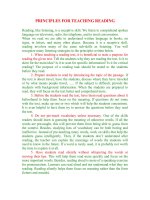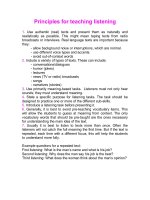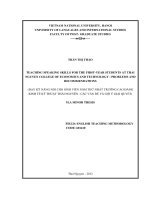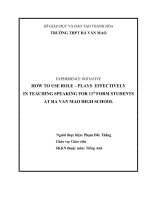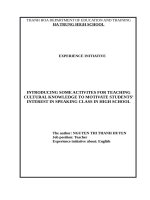PRINCIPLES FOR TEACHING SPEAKING
Bạn đang xem bản rút gọn của tài liệu. Xem và tải ngay bản đầy đủ của tài liệu tại đây (58.44 KB, 3 trang )
PRINCIPLES FOR TEACHING SPEAKING
Note: the following principles are divided into two groups: 1) Beginning
levels and 2) Intermediate and advanced levels. It is important to remember
that the goal in language use is natural communication and the principles for
the beginning levels point to and prepare for the principles given for the
intermediate and advanced levels. It is all too easy to be satisfied with
unnatural or repetitive speech. But the goal is natural communication in
which real information is transferred through speech.
Beginning levels:
1. Limit the objectives to avoid overwhelming the learners.
- provide your students with enough structured practice so they can
begin interacting at a basic level.
- this will reduce students’ fear and encourage more speaking.
- later, more free production can come after structured practice.
Example of structured practice for a beginner:
Teacher asks: What is he wearing?
Students answer: He is wearing a …
Example of a non-structured assignment:
Teacher: Please describe what he is wearing.
Students: ???
(Such an open-ended question can overwhelm a student if they have not first
been prepared through adequate practice)
2. Mix the speaking activities with comprehension work. That is, have the
students listen to the teacher or each other before they speak.
- when the students listen before they speak, it leads more natural
speech.
- comprehension work fosters an interaction between speaking and
listening.
- remember, we listened first before we began speaking, so speaking
should involve listening as well.
Example using comprehension work:
Teacher has students first listen to or read a dialogue. The class can
discuss the meaning of difficult words. After understanding the text, they
can practice the dialogue. (Speaking, or rather reading aloud, without
understanding has very little benefit. There is often no comprehension
involved in reading aloud).
3. Provide activities which involve dialogues and functional use of the
language.
- focus on language use rather than knowledge about language.
- functions involve a focus on meaning.
- dialogues are more concrete and controlled than less structured
drills.
Example of knowledge about a language:
A student can describe the structures and pans of speech in a language
Example of knowing how to use a language:
A student can introduce himself or herself, greet others, request
information, apologize, etc.
4. Do not emphasize the significance of mistakes.
- this encourages students to speak without fear of correction.
- this increases focus on meaning arid communication rather than
grammatical correctness (though such structural errors can also hinder
communication.)
- corrections should especially focus on problems affecting clear
communication or language already taught to the students.
5. State the purpose/goal of the activity to the students.
- this provides a context or focus to help comprehension.
- it also allows the learners to concentrate on the task and understand
why they are doing it.
Examples f purposes in speaking:
- “now we will practice describing our friends.”
- In this exercise we will learn to talk about clothing.”
- “in this activity we will practice asking for information.”
Intermediate and Advanced levels:
1. Focus on and work toward real, spontaneous speech.
- avoid from-based drills (repetitious or grammar-based exercises.)
- remember real speech is most often unrehearsed and unpracticed.
Examples of questions leading to real spontaneous speech:
- What did you do last night?
- What did you eat for breakfast this morning?
- What do you think about the new television program?
2. Design activities which encourage natural interaction between speakers.
- human speech most often involves interaction (Monologues are
rarely used).
- interaction integrates speaking and listening.
3. Place students in pairs, triads or small groups.
- smaller groups, and pairs are student-centered.
- this increases the quantity of speech spoken by the students.
- this decrease the vulnerability of the students and lowers their
anxiety level.
4. Provide topics of interest to the students.
- interesting topics increase students’ motivation.
- this also fosters a focus on meaning (and their personal feelings and
thoughts).
- it is good to ask students what they are most interested in.
5. At the advanced level, especially in free production, allow only speech in
the target language (English).
- this greatly increases the amount of English spoken.
- having clear guideline reduces the temptation of students to “hide”
in their native language.
- students may dislike this but should be discouraged from using their
own language without the teacher’s permission.
ST


